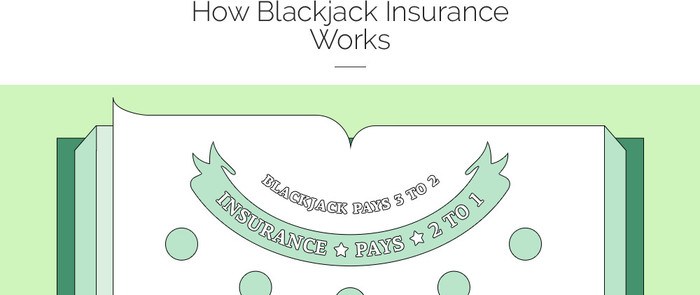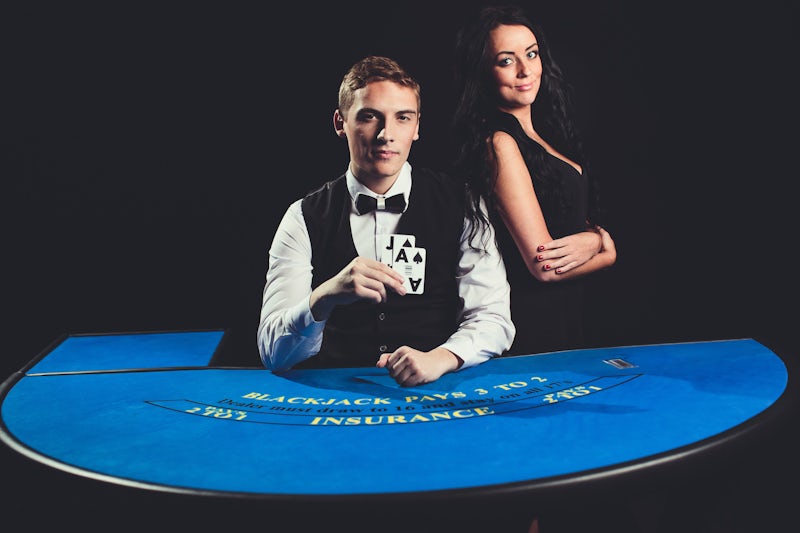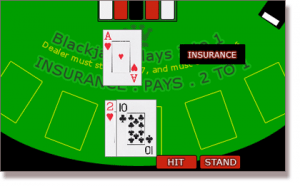- Blackjack Should You Buy Insurance Coverage
- Blackjack Should You Buy Insurance Online
- Blackjack Should You Buy Insurance For A
- Blackjack Should You Buy Insurance Without
Insurance is one of the many options offered to a blackjack player, but it is an option which is most often exercised incorrectly in live play. Insurance is a side bet which is considered independently of the main wager made by the player. All casinos offer insurance as a standard option. This is true in online casinos that offer blackjack also. Taking insurance at the blackjack table is a bad bet most of the time. If you’re a basic strategy player or a seat of your pants player and don’t count cards, your best play is to always decline blackjack insurance.

Nowadays, there are many different types of insurance one can buy – there is life insurance, car insurance, travel insurance, health insurance, property insurance, and liability insurance. You can even buy insurance in gambling establishments whenever you take a seat at one of their blackjack tables.
Blackjack Should You Buy Insurance Coverage
- Bonus⋆80 Free Spins
- Bonus$300
- $500$600
The latter is a type of proposition bet in blackjack that has been the subject of hot debates for decades. Few are bold enough to argue in favor of taking insurance but the vast majority of blackjack experts recommend you to refrain from ever making this bet. Let’s take a closer look at what insurance in blackjack is, how is it identical to the blackjack even-money payout, and why you should avoid both of them if you are a basic strategy player.
How Blackjack Insurance Works
Blackjack players are offered insurance whenever the dealer’s exposed card is an Ace. This is an optional proposition wager which is treated separately from your original bet. When you buy insurance, you are practically betting your dealer has a ten-value card in the hole next to their Ace for a blackjack.
You can insure any two-card hand against a dealer blackjack by betting up to half of your original wager. The chips for the insured bets are placed within the semicircular stripe that runs across the table and reads “Insurance Pays 2 to 1”. There are two possible scenarios when you take insurance.
If the dealer indeed has a blackjack and you do not, you lose your original stake but win the insurance bet at casino odds of 2 to 1, i.e. you end up breaking even for this round. Provided that the dealer does not have a ten-value card in the hole, you lose the insurance bet and play on your hand continues as usual.
Blackjack Insurance Additional TipsLet’s see how buying insurance works with a concrete example. We assume you have wagered $20 on your original hand, which is not a natural, and the dealer exposes an Ace. You want to protect yourself against a potential dealer blackjack and decide to accept insurance so you post an additional $10 bet on top of your initial $20.
The dealer peeks under their hole card and it turns out it is indeed a ten-value card giving them a blackjack. You lose the initial $20 you have staked on your hand but win another $20 from your insurance bet. You break even, i.e. you neither win nor lose money on this round. Had you not insured your hand, you would have been $20 down.
Is Taking Insurance Worth It?
Some players argue in favor of insurance and the basic premise of their argument is that you lose your entire initial bet if you do not insure your hand as opposed to breaking even when you accept insurance.
This “rationalization” is a load of bosh. Casino operators themselves want you to believe they are doing you a favor by allowing you to insure yourself against a possible dealer blackjack. Some dealers are even instructed to advise players on accepting insurance.
Blackjack Should You Buy Insurance Online
The truth of the matter is you are insuring nothing. What you are doing with this side bet is wagering the dealer has a ten-value card in the hole. This has nothing to do with boosting the odds of your original bet but it has everything to do with decreasing your long-term expected value and here is why.
Suppose you are playing a six-deck game where the ratio of non-ten cards to ten-value cards is 216 to 96. The six decks have just been reshuffled, the dealer exposes an Ace at the start of the first round, and offers you to buy insurance. Provided that we do not take into consideration the composition of your starting two-card total, the ratio of non-ten-value cards to ten-value cards is now 215 to 96 because one of the Aces has already left the shoe.
Therefore, if you insure your hand for a dollar 311 times, you will incur losses of $215 because the dealer’s hole card will not be a ten-value one 215 times. The other 96 times the dealer will have a ten-value card in the hole so you will win 96 * $2 for a total of $192. It follows that $311 worth of insurance side bets is equal to net losses of $215 – $192 = $23.
Thus, insurance puts you at a massive disadvantage of (-$23 / $311) *100 = -7.39% which means the house holds an edge of nearly 7.40% with this side bet. No wonder dealers are recommending patrons to insure their hands!

Taking Insurance Additional TipsWhat if we introduce your starting two cards into the equation? Let’s imagine your hand consists of two non-ten-value cards like 6 and 2 for a total of 8 while the dealer’s upcard is an Ace at the start of the first round.
You are again playing at a six-deck blackjack table, which is to say the ratio of non-ten-value cards to ten-value cards in the shoe is 213 to 96 because three non-ten cards have already been removed (the dealer’s Ace, a 6, and a 2).
The shoe now contains only 309 cards so you will lose a dollar 213 out of 309 times and win $2 * 96 for a profit of $192. So $309 worth of $1 insurance bets results in net losses of $213 – $192 = $21. This puts you at a disadvantage of (-$21 / $309) * 100 = -6.80%. There is a slight improvement in the odds but you are still losing lots of money by buying insurance.
Some people argue you must insure only pat hands (like hard 20 and naturals) and decline insurance when you have bad hands like hard 12 or hard 13. Let’s put this argument to rest with our last example where some of the face cards are removed from the shoe at the first round of play. Your starting hand is a pair of Queens against the dealer’s Ace.
Out of 309 cards left, you have 94 ten-value cards and 215 non-ten-value cards because one of the Aces has been removed. If you take insurance for $1 309 times under these circumstances, you end up losing $215 and winning 94 * $2 = $188. The net loss you incur after placing $309 worth of $1-dollar insurance bets on a pat 20 stands at $27. This puts you at a disadvantage of (-$27 / $309) * 100 = -8.73%.
It turns out insuring “good” hands is costlier than insuring “bad” ones because some of the ten-value cards that can help the dealer make a blackjack are already out of play. No matter how we beat about the bush, insurance is a bad bet and as such, should be altogether avoided.
But There Are Exceptions to Any Rule

If you take the time to examine a basic strategy chart closely, you will surely notice one strange phenomenon. The correct plays for splitting, hitting, standing, doubling, and surrendering against all possible dealer cards are listed while insurance is strangely absent from the chart. Why is that?
The reason is simple – basic strategy players should never take insurance because it is a negative-expectation bet in the long term. The odds of winning with this wager are slimmer than the odds the casino pays you at. Of course, there are exceptions to all rules, including this one because the insurance bet is susceptible to advantage-play techniques such as card counting.
Card counters keep track of the ratio of ten-value to non-ten-value cards that remain in the shoe or deck. This gives them the opportunity to identify the situations in which insurance becomes a positive-expectation bet. When the remaining ten-value cards outnumber the non-ten-value cards, a card counter is more likely to insure their hands against a dealer blackjack.
Additional ExceptionsConsider the following situation where you are playing a pitch game which uses a single deck containing 52 cards in total. During the first round after the dealer reshuffles, you take a look at your starting hand and see it consists of two small cards, say 6-3. You also manage to catch a glimpse of the hand of the other player sitting at the table and see it also consists of two small cards, 4-5. Your dealer is showing an Ace.
This means 5 cards with a value other than ten are no longer in play and the deck is now left with 47 cards in total. The odds of the dealer having a blackjack are now 31 to 16 because we have 31 non-ten-value cards and 16 ten-value cards. Respectively, the implied probability of you winning your insurance bet is 1 in 47, which corresponds to a likelihood of 2.13%.
After making $47 bets (of $1 each) worth of insurance, you will lose $31 and win 16 * $2 = $32.You have a net profit of $1 obviously while the house is at a slight disadvantage in this case, which is equal to $1/$47 * 100 = 2.13%. Insurance becomes a positive-expectation bet under these circumstances.
The Blackjack Even-Money Payout
The even-money payout is offered when players obtain a blackjack and the dealer exposes an Ace. Most inexperienced gamblers get confused when this happens and often end up asking fellow patrons or the dealer for advice. Should they accept the even-money payout or should they decline? And of course, the dealer would always recommend them to accept even money because this way, they will not lose anything during this round.
This is a bad piece of advice which you should never take. Here is the thing – the even-money payout is basically the same thing as insurance with a few tiny differences. The first difference is that this is a possible option only when the player has a blackjack and the dealer shows an Ace. Also, if you accept even money, the dealer would pay you out before he or she peeks under their hole card for a blackjack, unlike winning insurance bets which are paid after the peek.

The Even-Money Payout is Insurance in Disguise
Insurance and even money are the two sides of one and the same coin. Let’s take a look at a few examples to see why. In the first scenario, you insure your blackjack for $10 but the dealer also has a natural. The two blackjacks push, so you end up winning $20 in net profits.
Blackjack Should You Buy Insurance For A
In the second scenario, you again decide to accept insurance but it turns out the dealer does not have a natural. You lose your $10 insurance bet but the blackjack earns you $30 (1.5 times your initial $20 bet) for a net profit of $20.
The third possible situation you can find yourself in is when you decline insurance but the dealer also ends up having a natural. The two blackjacks push again and you neither lose nor win anything.
And finally, we have the situation where you decline buying insurance and the dealer does not have a ten-value card in the hole. In this case, you earn $30 in net profits plus your initial $20 stake. It follows that if you always accept insurance on your blackjacks, you inevitably end up winning even money whether or not the dealer also has a natural.
By offering you even money before the dealer peeks for a blackjack, casinos simply spare you the hassles of insuring your hand. Inexperienced players reason accepting even money is a good alternative because if they decline and the dealer also ends up with a blackjack, the two naturals will push, i.e. they will not earn any payout.
They seem to believe a profit of one base-bet unit is better than no profit at all. What they fail to understand is that if they decline the even-money payout (or insurance for that matter) and the dealer does not have a ten-value card in the hole (which is more probable because some ten-value cards have already been removed from the shoe/deck), they miss out on the lucrative opportunity to earn 1.5 times their initial wager.
When you receive a natural in a six-deck game against a dealer’s Ace, the dealer’s hole card will be a ten-value one 95 out of 309 times, which corresponds to implied probability of 95 / 309 * 100 = 30.7%. It follows that when you insure your hand, you end up winning even money 30.7% of the time.
If you decline insurance, 30.7% of the time your blackjack will push with that of the dealer so you neither win nor lose anything. The remaining 69.3% of the time, you stand a better chance of winning 1.5 times your initial bet.
Therefore, the probability of you winning 1.5 times your bet when declining the even-money payout is higher than that of pushing with the dealer. You earn 1.5 * 69.3% = $1.03 per every dollar wagered on average each time you decline even money.
Blackjack Should You Buy Insurance Without
The bottom line is basic strategy players should never insure their hands or accept even-money payouts on their naturals. Blackjack is difficult enough to beat without players pouring some of their profits back into the casinos’ coffers.